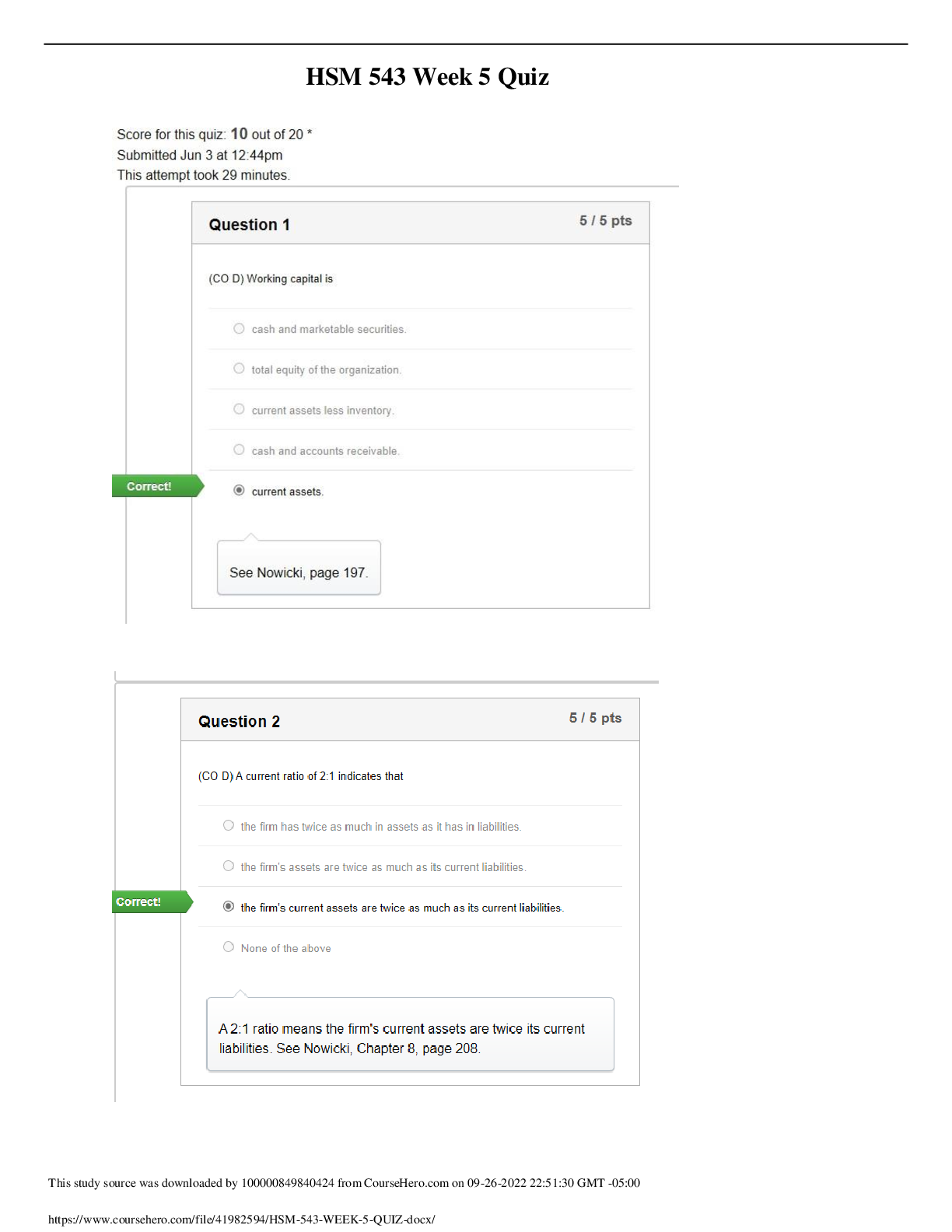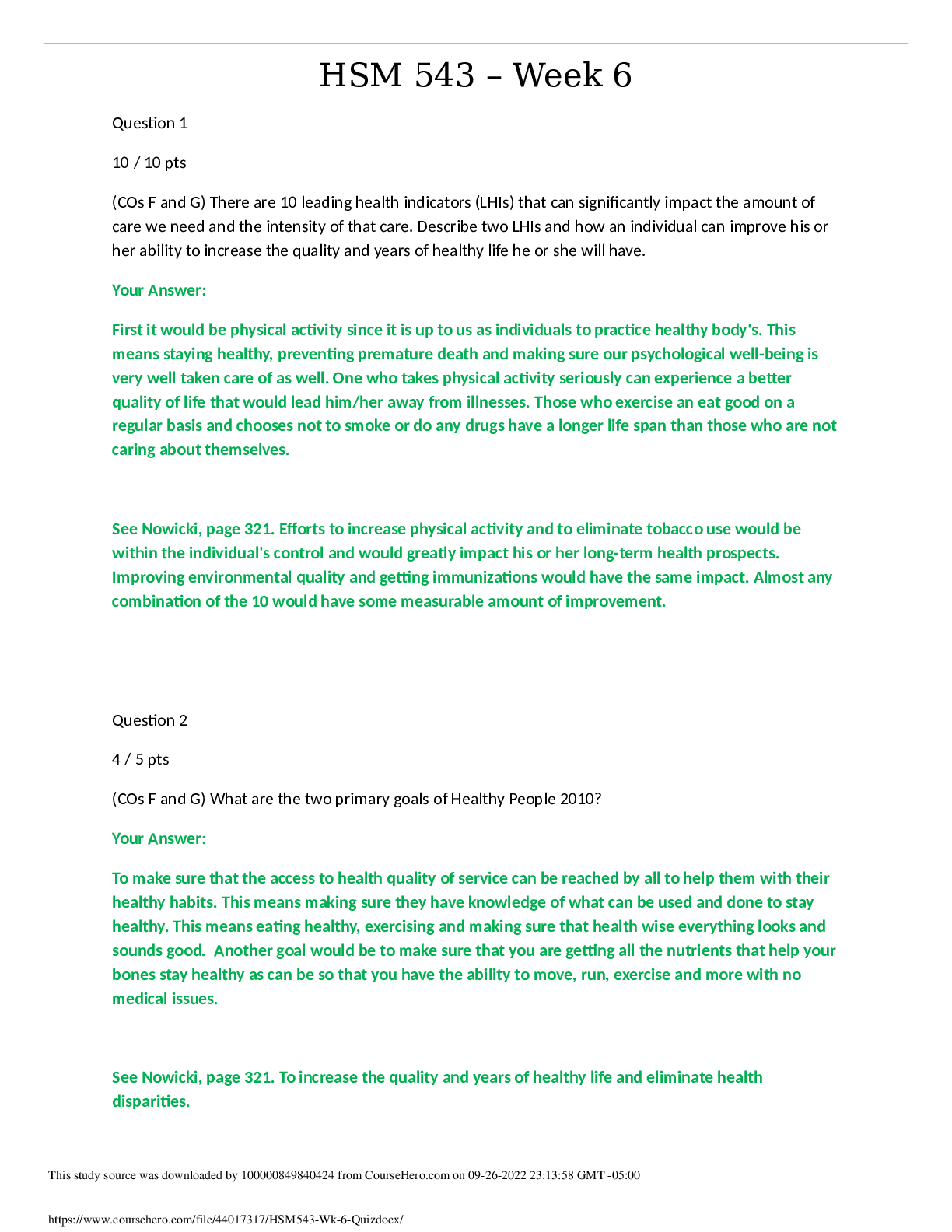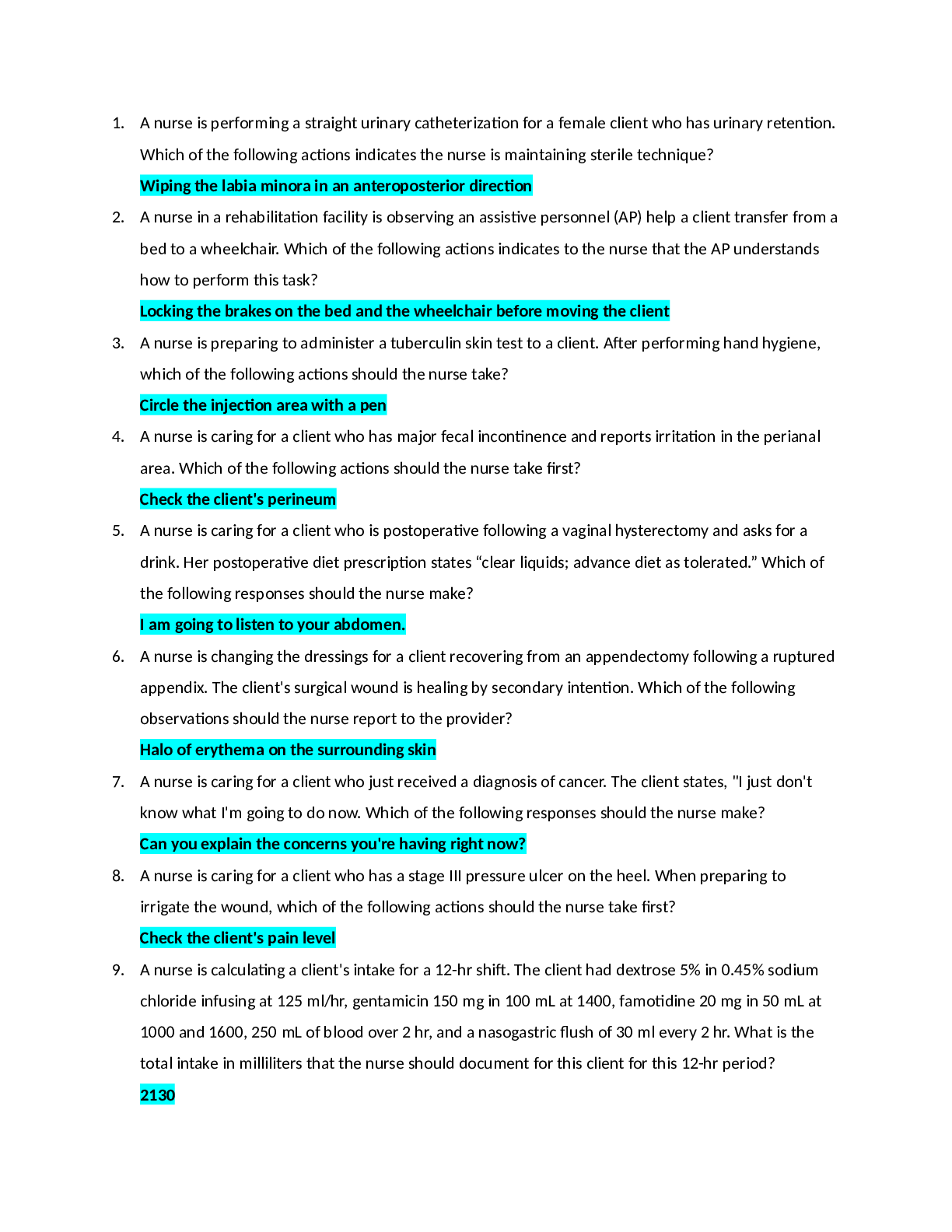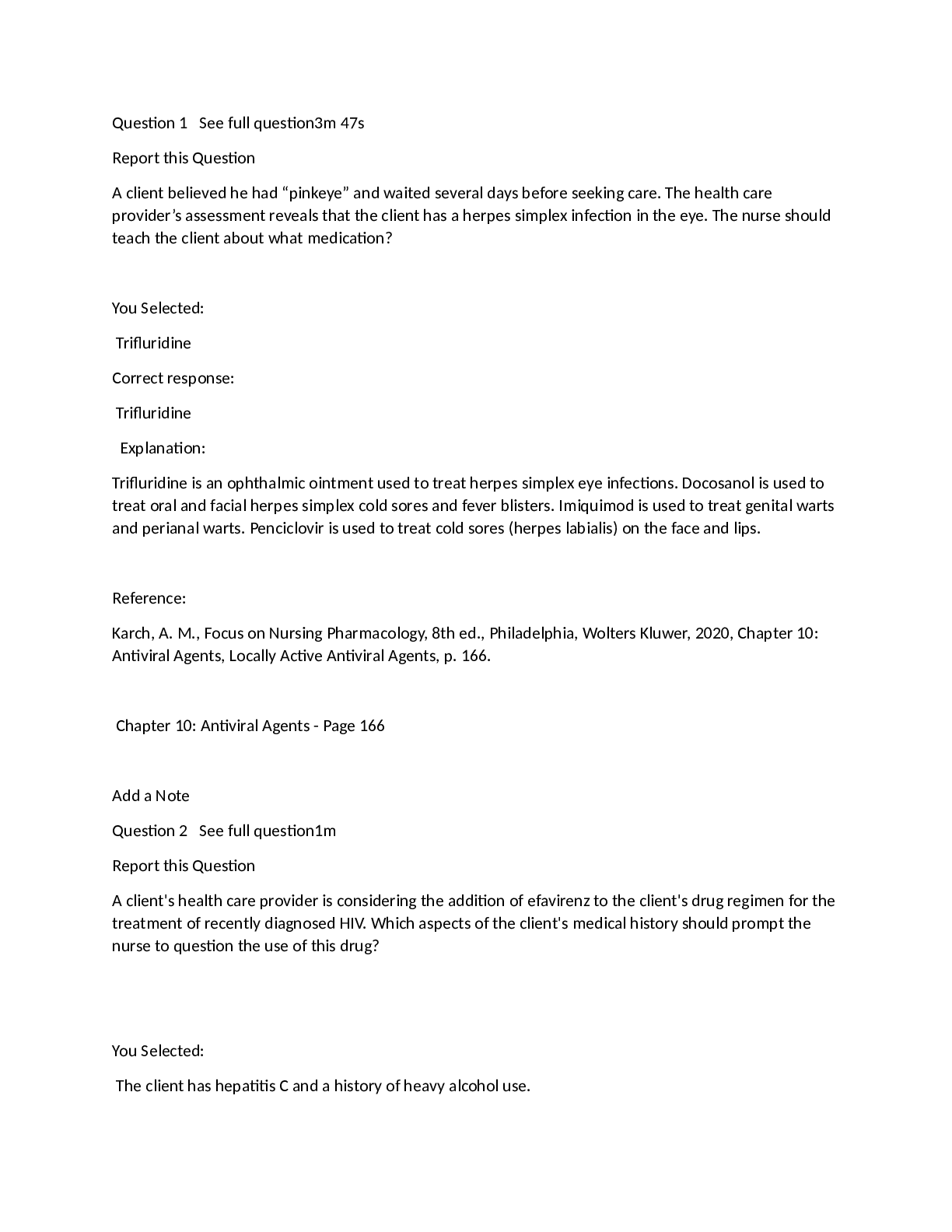Biology > EXAM > A&P 1 101 Module 3 exam 3 Digestive system Question/ Answers | Download To Score An A (All)
A&P 1 101 Module 3 exam 3 Digestive system Question/ Answers | Download To Score An A
Document Content and Description Below
A&P 1 101 Module 3 exam 3 Digestive system Question 1 5 / 5 pts Explain why a patient with liver disease would have intolerance to fatty foods. Your Answer: Because one of the function of the... liver is to produce bile. Bile is used to emulsify fat, if the fat cannot be broken down, the patient will have intolerance with fatty foods. The liver produces bile which breaks down fats. If it is not producing bile (or less bile), fats will not be broken down effectively. Question 2 5 / 5 pts Explain in detail how the stomach contents enter the small intestine. Your Answer: First, the contents enters the small intestine through pyloric sphincter. The pyloric sphincter then relaxes and small amount of chyme pass through into the small intestine. A reflex occurs after chyme enters the small intestine which causes sphincter to close. Once sphincter relaxes again some more chyme enters and this process continues. The pyloric sphincter (valve), located at the base of the stomach, relaxes causing a small quantity of chyme to pass through the opening into the first part of the small intestine. This initiates a reflex that causes the muscles of the sphincter to contract and close the opening temporarily. Then the sphincter relaxes again and allows more chyme to enter. Question 3 10 / 10 pts Look carefully at the diagram below. Label the following 5 organs of the digestive system. To receive credit for the intestines you must label the specific region. 1: 2: 5: 6: 8: Your Answer: 1- Liver 2- Pancreas 5-Duodenum 6-Ileum 8-Ascending colon 1: Liver 2: Pancreas 5: Duodenum (not small intestine) 6: Ileum (not small intestine) 8: Ascending colon (not large intestine) Question 4 5 / 5 pts A patient is experiencing vitamin toxicity. What type of vitamin would be causing this toxicity? Explain your answer. A. Water soluble vitamin B. Fat soluble vitamin C. All of the above Your Answer: B. Fat soluble vitamin. Fat soluble vitamin is stored within the bodys fat. It is harder for the body to get rid of them. B. Fat soluble vitamin. Fat soluble vitamins are stored within the body’s fat stores making it harder for the body to rid itself of them. Question 5 5 / 5 pts Explain which digestive system functions are carried out by the large intestine. Your Answer: Absorption and defecation. Absorption: water and electrolytes are reabsorbed. Vitamins are absorbed. Defecation: feces travel to the rectum. Feces are excreted via anus. Absorption: In the large intestine water and electrolytes are reabsorbed and vitamins are absorbed. Defecation: Feces travel to the rectum where it is excreted via the anus. Question 6 10 / 10 pts Note: Essay answers must clearly be in your own words. Answer the following essay question: Name and explain the four main functions performed by the digestive system. Your Answer: 1- Ingestion: happens when food enters the mouth 2- Digestion: happens when the food meets the enzymes along the GI tract. Digestion has 2 parts: A-Mechanical : Happes when food is brakes down into smaller pieces. B-Chemical: Happens when the food is broken down by enzymes. 3- Absorption: Moving digested food in to the blood stream. 4-Defecation: Getting rid of undigested food from the anus The digestive system has four main roles that it performs: ingestion, digestion, absorption, and defecation. Ingestion is when food enters the mouth. Digestion or food breakdown occurs when food is moved, mixed, and exposed to enzymes along the gastrointestinal tract. Digestion can be divided into two parts: mechanical and chemical digestion. Mechanical digestion occurs when food is broken down into smaller pieces. This occurs when the teeth chew food, when the stomach mixes food, and as food is moved along the gastrointestinal tract. Chemical digestion is the breakdown of food by enzymes. Absorption is the process of moving digested food into the blood stream. Defecation is the excretion of indigestible food from the anus. Question 7 4 / 4 pts Match the digestive organ with the one substance it produces: Correct! Pancreas Correct! Liver Correct! Mouth Other Incorrect Match Options: • Vitamin E • Chyme • Pepsinogen Question 8 3 / 3 pts What is the purpose of the hormone Leptin? Increase hunger, decrease satiety Increase hunger, increase satiety Correct! Decrease hunger, increase satiety Decrease hunger, decrease satiety Question 9 3 / 3 pts Which of the following statements is false? Taste buds are located on the surface of the mouth and the wall of the pharynx. Correct! The ileocecal valve controls the entrance of chyme into to the small intestine. (It controls the entrance to the large intestine) The gall bladder, teeth, and tongue are considered accessory organs to the digestive system. The alimentary canal is a continuous muscular tube, open at both ends. Question 10 2 / 2 pts Lipids can be divided into two categories: complete or incomplete. True Correct! False (Proteins can be divided into these two categories) Question 11 2 / 2 pts True/False: Catabolism combines smaller molecules to make larger molecules. True Correct! False (Anabolism) Question 12 2 / 2 pts True/False: The nasopharynx is the most superior region of the pharynx. Correct! True False Question 13 2 / 2 pts True/False: The pharynx has two types of skeletal muscle: circumferential and oblique. True Correct! False (It does not include an oblique layer) Question 14 2 / 2 pts True/False: The digestive work of salivary amylase is an example of mechanical digestion. True Correct! False (Chemical digestion) Question 15 7.5 / 10 pts Label the following three types of raised bumps on the tongue. Describe the purpose of type B. A: B: C: Describe B: Your Answer: A-Filiform Pappillae B. Circumvallate papillae C. Fungiform papillae A: Filiform papillae B: Circumvallate papillae C: Fungiform papillae Describe B: Papillae are raised bumps on the tongue. The three types of papillae help to grip food on the tongue: circumvallate, fungiform and filiform. Circumvallate papillae contain taste buds. Question 16 4 / 4 pts Which of the following statements is true concerning glycolysis? Pyruvic acid are broken down into glucose. Correct! Two ATP molecules are formed in first breakdown of glucose. Glucose is broken down into three pyruvate molecules. Glucose is broken down into two sucrose molecules. Question 17 3 / 3 pts Which of the following statements is true concerning the second stage of glucose breakdown? This is also known as proton motive force. Fermentation takes place here with oxygen present. Correct! Two additional ATP are formed along with other electron carriers. Glucose molecules are formed. Question 18 3 / 3 pts Which of the following statements is true concerning the Electron Transport System? Can proceed can proceed only aerobically Approximately a total of 2 ATP are formed. Correct! Protons are pumped out of the inner mitochondrial membrane. The proton motive force forms ADP. Question 19 10 / 10 pts Label the diagram below, including left or right. Discuss the purpose of tooth (B). A: B: C: F: Purpose of tooth type B: Your Answer: A: mandible B: Right molar - C: Right premolar F: Right central incisor Purpose of right molar: crushing the food A: Mandible B: Right Molar C: Right Premolar (bicuspid) F: Right Central Incisor Purpose of tooth type B: Flat molars for crushing food Question 20 2 / 2 pts Match the structure with the best description: Pancreas: Storage site for bile Attached to the soft palate Correct! Secretes juices which digest all types of foods Stores glycogen and produces urea Forms food into a bolus Question 21 2 / 2 pts Match the structure with the best description: Stomach: Hangs from the cecum Connects mouth to esophagus Correct! Attaches to the greater omentum Contains the hepatic flexure Site of the ileocecal valve Question 22 2 / 2 pts Match the structure with the best description: Muscularis externa (layer of tissue): Correct! Made of two layers of muscle Innermost layer Secretes mucous Contains blood and lymph vessels Begins in the mouth Question 23 2 / 2 pts Match the structure with the best description: Dentin: Upper portion of gums Outermost layer Correct! Bone-like substance Hard connective tissue Contains longitudinal muscle Question 24 2 / 2 pts Match the structure with the best description: Common Bile Duct Contains secretions from the pancreas Correct! Joins with the pancreatic duct Enters the jejunum Contains secretions from the salivary glands Contains lymph vessels and nerves [Show More]
Last updated: 1 year ago
Preview 1 out of 13 pages

Reviews( 0 )
Document information
Connected school, study & course
About the document
Uploaded On
May 10, 2022
Number of pages
13
Written in
Additional information
This document has been written for:
Uploaded
May 10, 2022
Downloads
0
Views
27






.png)












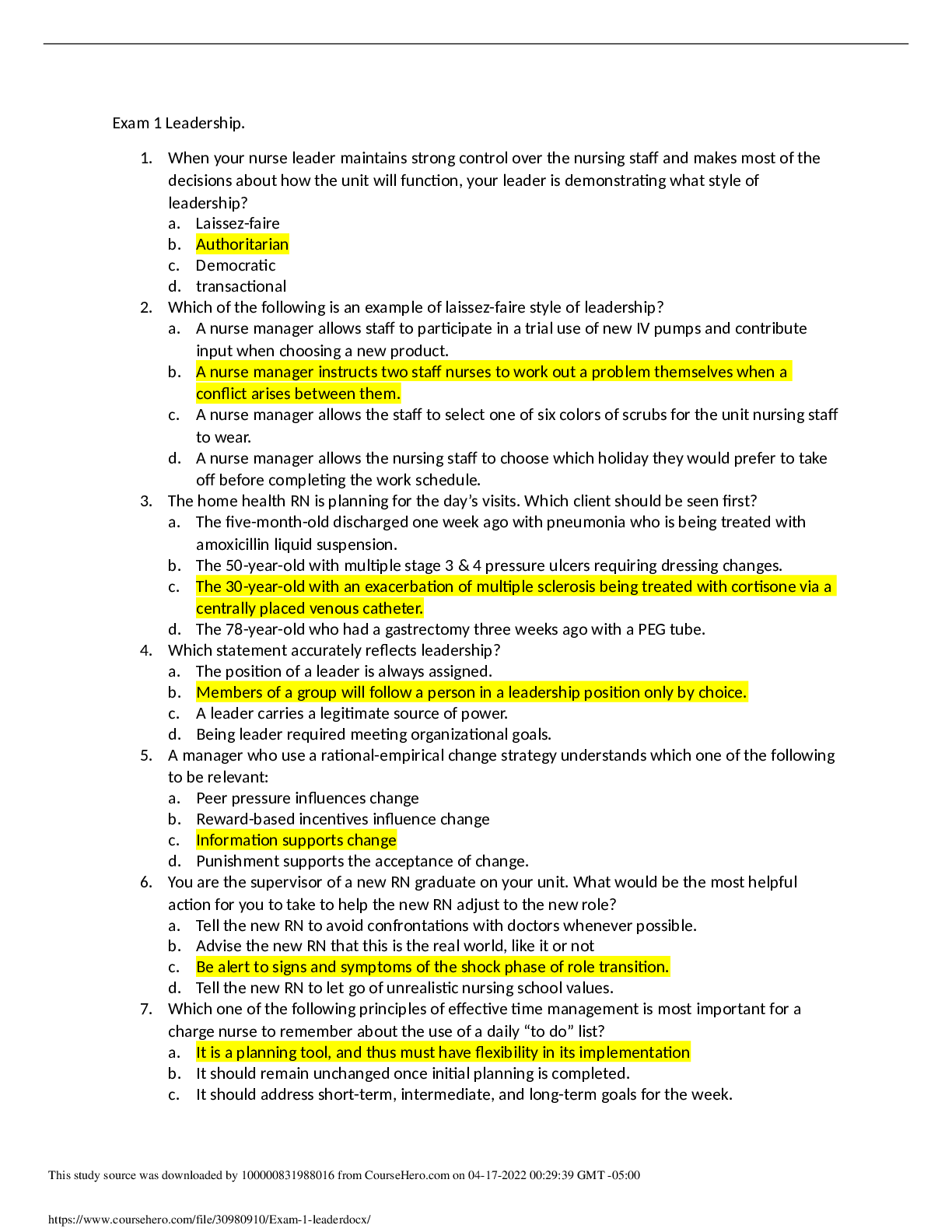
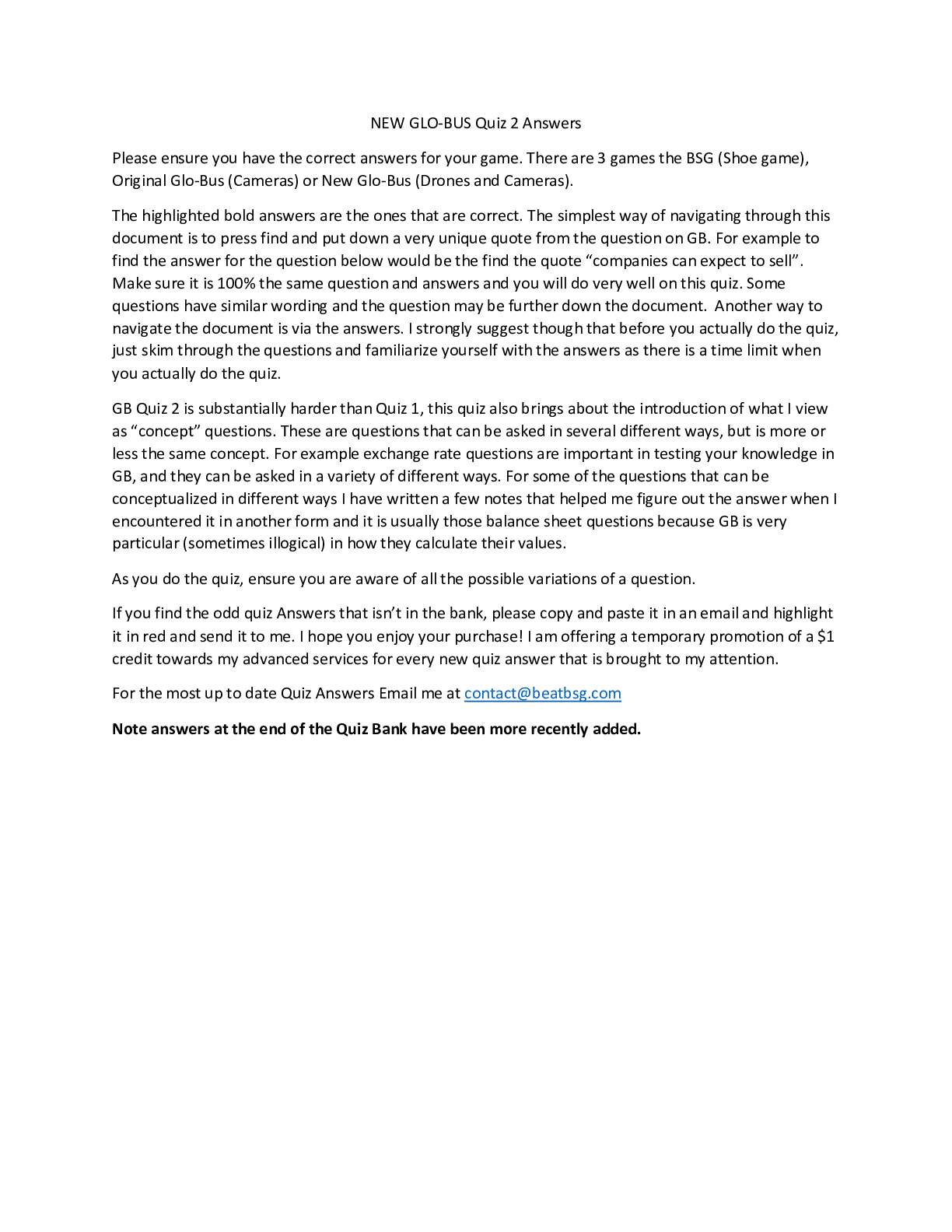
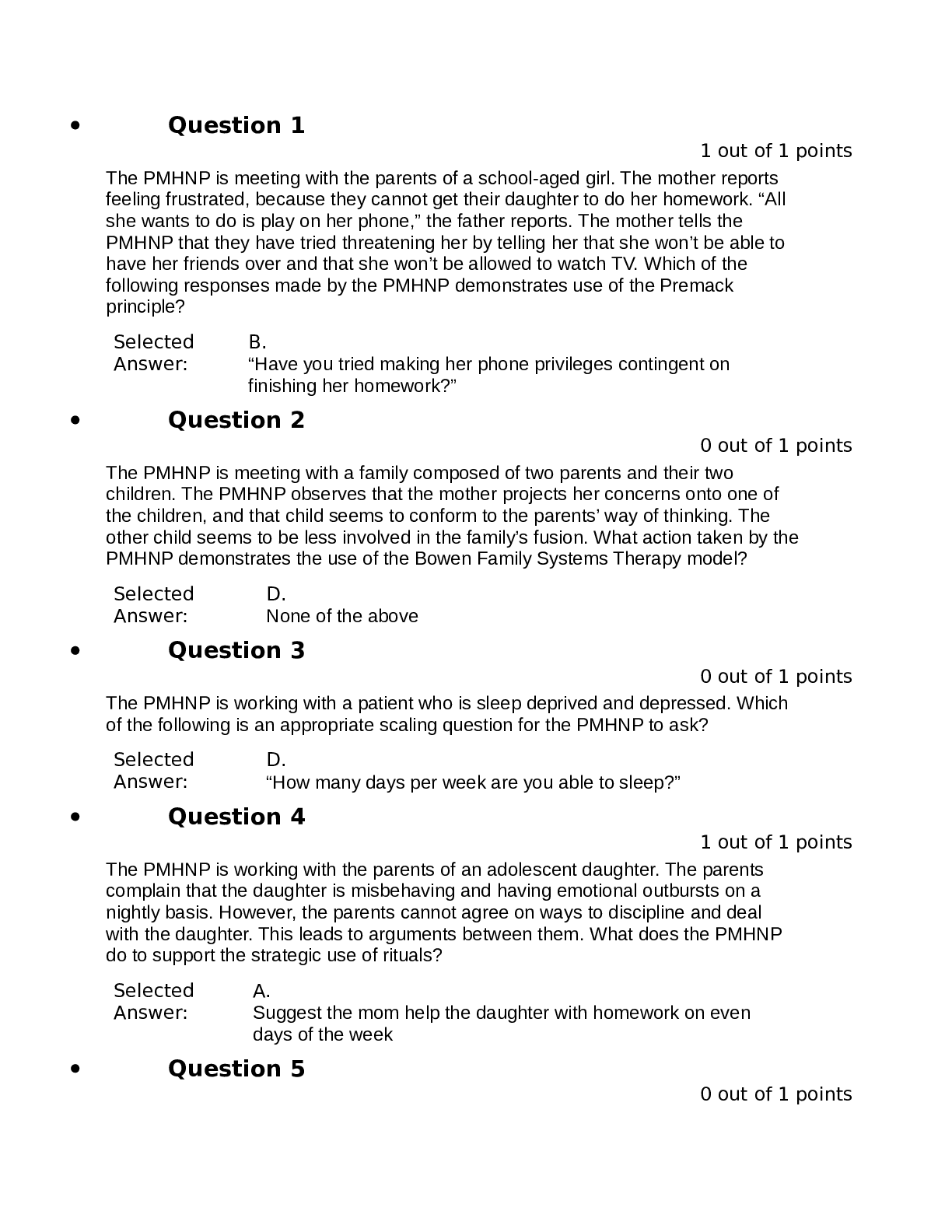

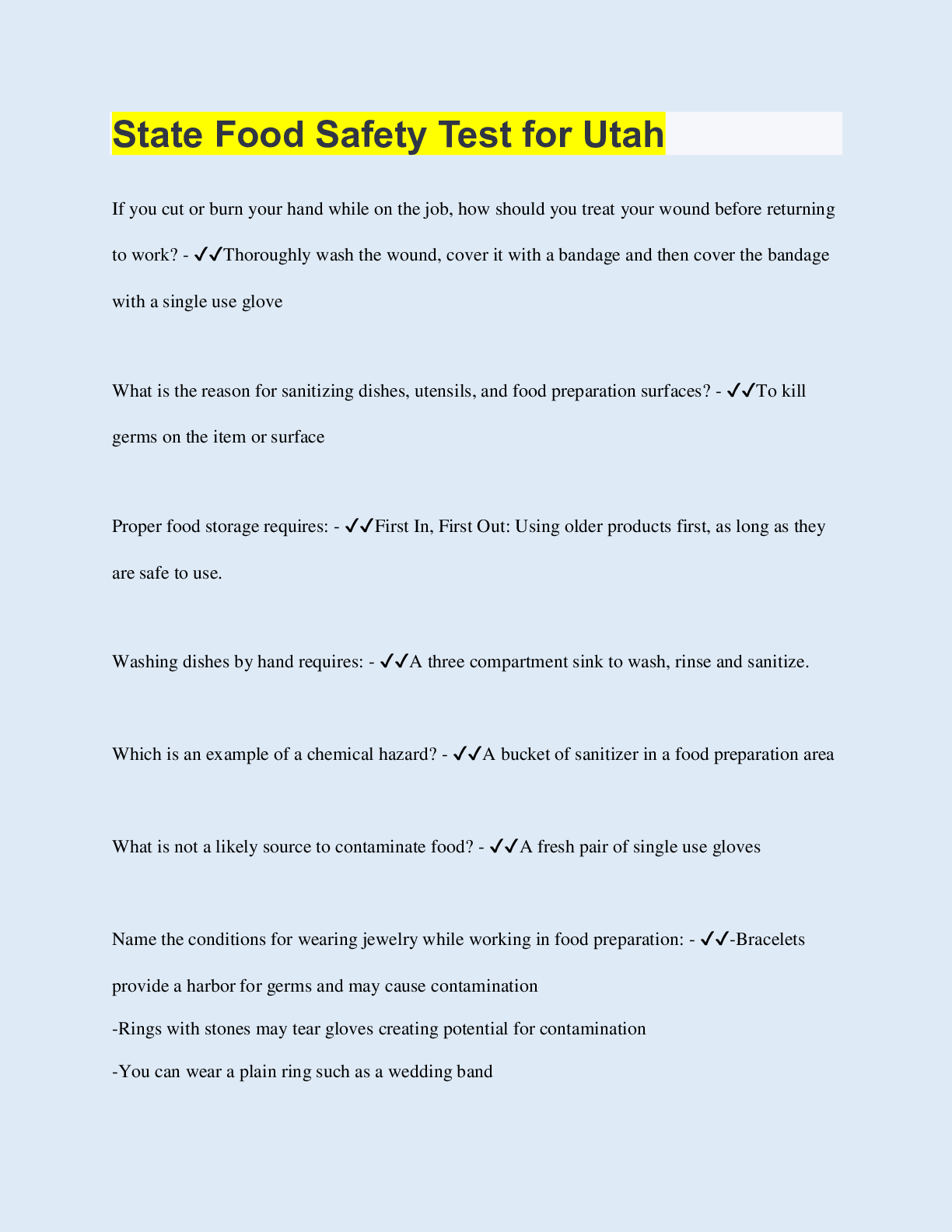


.png)
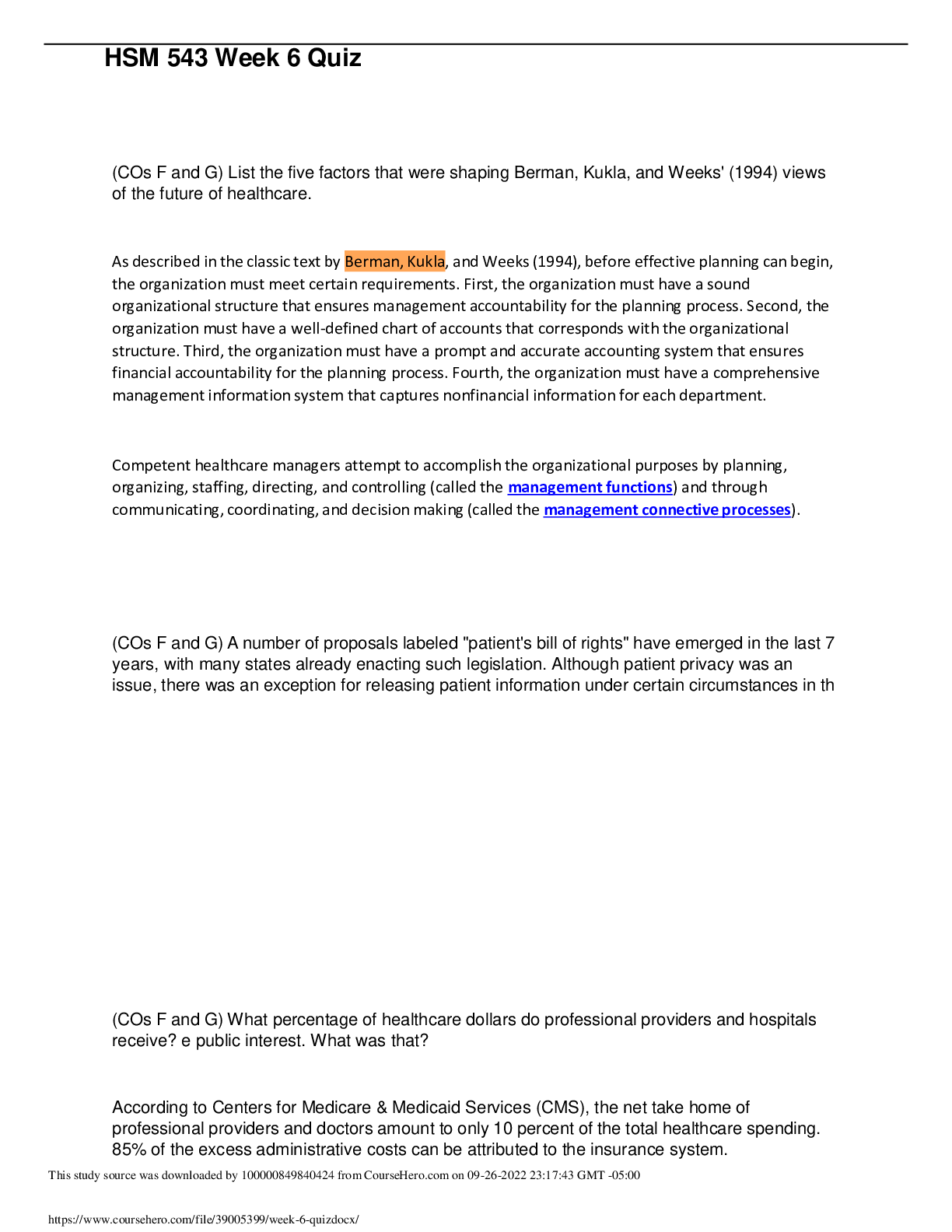
 (1).png)
